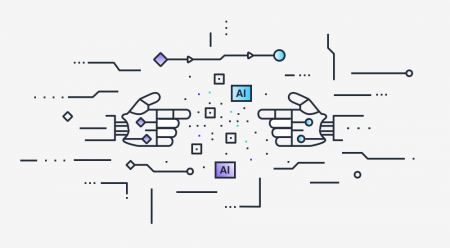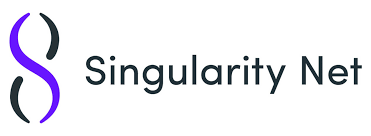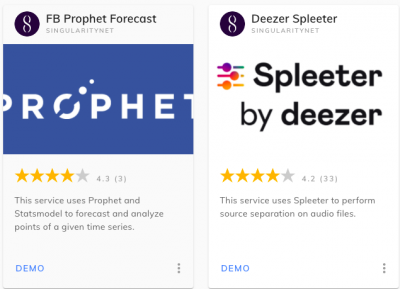Difference between revisions of "SingularityNet"
(final) |
(Wording, Links, and Source update (minor)) |
||
| Line 2: | Line 2: | ||
[[File:Signet.png|thumb|700px|SinglarityNet Logo]] | [[File:Signet.png|thumb|700px|SinglarityNet Logo]] | ||
| − | '''SingularityNet''', founded by blockchain/AI entrepreneurs Ben Goertzel, David Hanson, and Simone Giacomelli provides a decentralized protocol and network on which AI services can cooperate, coordinate, and interoperate<ref name = "SingularityNet: A Decentralized, Open Market and Network for AIs">SingularityNet (2019). [https://public.singularitynet.io/whitepaper.pdf | + | '''SingularityNet''', founded by blockchain/AI entrepreneurs Ben Goertzel, David Hanson, and Simone Giacomelli, provides a decentralized protocol and network on which AI services can cooperate, coordinate, and interoperate<ref name = "SingularityNet: A Decentralized, Open Market and Network for AIs">SingularityNet (2019). [https://public.singularitynet.io/whitepaper.pdf |
| − | ]. ''SingularityNet Whitepaper 2.0''. Retrieved Mar 8, 2021. </ref>. Due to its decentralized nature, anyone from around the world can take part in creating or utilizing an AI service, as well as staking the native token ($AGI) to facilitate marketplace operations and earn a reward. Critically, [https://singularitynet.io/ SingularityNet] shifts the barrier of entry downwards for engaging in the world of research-grade artificial intelligence services. Given the corporate trajectory of establishing siloed AI, a distributed network for AI services will aid in establishing a level playing field for reaping the benefits of AI tools of the future. Though still in its technical infancy, its theoretical potential has gained the attention of mainstream media outlets<ref name = "AI Is The Future Of Computing, And SingularityNET Is The Future Of AI">Damiani, Jesse (2017). [https://www.forbes.com/sites/jessedamiani/2017/12/11/ai-is-the-future-of-computing-and-singularitynet-is-the-future-of-ai/]. ''AI Is The Future Of Computing, And SingularityNET Is The Future Of AI''. Retrieved Mar 8, 2021. </ref> and hackers alike. | + | ]. ''SingularityNet Whitepaper 2.0''. Retrieved Mar 8, 2021. </ref>. Due to its decentralized nature, anyone from around the world can take part in creating or utilizing an AI service, as well as staking the native token ($AGI) to facilitate marketplace operations and earn a reward. Critically, [https://singularitynet.io/ SingularityNet] shifts the barrier of entry downwards for engaging in the world of research-grade artificial intelligence services. The SingularityNet community, blog, and YouTube channel all provide valuable perspective on the development of decentralized services relating to AI, as well as some well needed ‘big picture’ information for this period of technological change. Given the corporate trajectory of establishing siloed AI, a distributed network for AI services will aid in establishing a level playing field for reaping the benefits of AI tools of the future. Though still in its technical infancy, its theoretical potential has gained the attention of mainstream media outlets<ref name = "AI Is The Future Of Computing, And SingularityNET Is The Future Of AI">Damiani, Jesse (2017). [https://www.forbes.com/sites/jessedamiani/2017/12/11/ai-is-the-future-of-computing-and-singularitynet-is-the-future-of-ai/]. ''AI Is The Future Of Computing, And SingularityNET Is The Future Of AI''. Retrieved Mar 8, 2021. </ref> and hackers alike. |
| − | + | ||
==Decentralizing AI Services== | ==Decentralizing AI Services== | ||
===Publishing=== | ===Publishing=== | ||
| − | The publishing process on SingularityNet is structured in a way that any individual or group with an internet connection can establish an Ethereum identity and link their computers as a cluster to begin working on the creation of AI “agents”. | + | The publishing process on SingularityNet is structured in a way that any individual or group with an internet connection can establish an Ethereum identity (soon to be a Cardano identity<ref name = "Cardano SingularityNet proposal explanation">SingularityNet (2021). [https://blog.singularitynet.io/singularitynet-phase-two-massive-token-utilization-toward-decentralized-beneficial-agi-6e3ac5a5b44a]. ''Cardano and SingularityNet proposal explanation''. Retrieved Mar 26, 2021. </ref>) and link their computers as a cluster to begin working on the creation of AI “agents” – another way of saying semi-autonomous machine learning algorithm. Currently, using the Ethereum Ropsten testnet, a team or individual has plenty of room to toy with and tweak the AI before publishing to the SingularityNet open marketplace which runs on the Ethereum mainnet. In this testnet environment, they have access to faucets for testnet ETH and AGI, allowing them to fuel any tests necessary to confirm that their "agent" is prepared for the mainnet marketplace. Once polished, the individual or team releases their agent to the market, wherein its services are purchased for some set cost paid in AGI, which the individual or team then receives. |
===Marketplace=== | ===Marketplace=== | ||
[[File:Shot.png|thumb|400px|Two ML demos on the marketplace]] | [[File:Shot.png|thumb|400px|Two ML demos on the marketplace]] | ||
| − | The [https://beta.singularitynet.io/ marketplace] itself is something like a bazaar for AI/machine learning services. At the time of writing, the vast majority of the services are agents created by SingularityNet to provide cheap demos for the kinds of services that would be available once | + | The [https://beta.singularitynet.io/ marketplace] itself is something like a bazaar for AI/machine learning services. At the time of writing, the vast majority of the services are agents created by SingularityNet to provide cheap demos for the kinds of services that would be available once institutional adoption occurs. An example of the kinds of services currently available at the marketplace includes algorithms such as those that aid in colorizing and [https://beta.singularitynet.io/servicedetails/org/snet/service/deoldify-colorizer restoring black and white photographs], or another that helps to [https://beta.singularitynet.io/servicedetails/org/mozi/service/gene-annotation-service annotate and represent] genetic data. |
===Request For AI=== | ===Request For AI=== | ||
| − | Integral to the smooth functioning of the marketplace is the Request For AI<ref name = "Request For AI Service">SingularityNet (2020). [https://dev.singularitynet.io/products/rfai/]. ''Requesst for AI Service''. Retrieved Mar 9, 2021. </ref> (RFAI) functionality. In essence, RFAI allows the community to | + | Integral to the smooth functioning of the marketplace is the Request For AI<ref name = "Request For AI Service">SingularityNet (2020). [https://dev.singularitynet.io/products/rfai/]. ''Requesst for AI Service''. Retrieved Mar 9, 2021. </ref> (RFAI) functionality. In essence, RFAI allows the community of developers and general token holders to create specific requests for well-defined services and to fund requests which have already been made using the AGI token. Once developers propose various solutions to some request, those who have funded the request will vote on which solution functions optimally, and the AGI which tokens used to fund the request will be distributed according to the voting distribution <ref name = "Request For AI Service">SingularityNet (2020). [https://dev.singularitynet.io/products/rfai/]. ''Developer Documentation''. Retrieved Mar 9, 2021. </ref>. After the voting is ended and developers claim their proportion of the AGI tokens, the request is closed, though the solution can be made available by the developer in the marketplace. |
===Native Token: AGI=== | ===Native Token: AGI=== | ||
| − | The vast majority of blockchain protocols have a unit of value (a token) used to transact and serve as the backbone for other technical functions. For SingularityNet, this token is AGI<ref name = "Exploring the Utility of SingularityNET’s AGI Token">Mari, Marcello (2017). [https://blog.singularitynet.io/exploring-the-utility-of-singularitynets-agi-token-2006639ccd40]. ''Exploring the Utility of SingularityNET’s AGI Token''. Retrieved Mar 9, 2021. </ref>. The ticker is a play on words for the abbreviation of "artificial general intelligence", which is | + | The vast majority of blockchain protocols have a unit of value (a token) used to transact and serve as the backbone for other technical functions. For SingularityNet, this token is AGI<ref name = "Exploring the Utility of SingularityNET’s AGI Token">Mari, Marcello (2017). [https://blog.singularitynet.io/exploring-the-utility-of-singularitynets-agi-token-2006639ccd40]. ''Exploring the Utility of SingularityNET’s AGI Token''. Retrieved Mar 9, 2021. </ref>. The ticker is a play on words for the abbreviation of "artificial general intelligence", which is described as the precursor step to a technological, AI singularity. The AGI token serves a host of functions, foremost serving the unit of value when users and AI agents are performing transactions. As these agents go about performing on various other platforms, the AGI token serves as an anchor for settlement<ref name = "Exploring the Utility of SingularityNET’s AGI Token">Mari, Marcello (2017). [https://blog.singularitynet.io/exploring-the-utility-of-singularitynets-agi-token-2006639ccd40]. ''Exploring the Utility of SingularityNET’s AGI Token''. Retrieved Mar 9, 2021. </ref> when one agent ‘pings’ the use of various others. In addition, agents are required to stake<ref name = "SingularityNet Developer Documentation">SingularityNet (2020). [https://dev.singularitynet.io/products/staking/]. ''Why the AGI Token Needs Staking''. Retrieved Mar 9, 2021. </ref> an amount of AGI tokens to go about performing on the network. This stake can be partially drained if their ranking drops below a certain level, thus incentivizing performance. AGI is also used by the community to fund the development of AI and machine learning services via the RFAI functionality. |
| Line 26: | Line 25: | ||
However, with a technology like SingularityNet, its political form skews inherently<ref name = "Do Artifacts Have Politics?"> Winner, Langdon (1980). [https://www.jstor.org/stable/20024652?seq=1]. ''Do Artifacts Have Politics?''. Retrieved Mar 12, 2021. </ref> towards democratizing the way value flows through data processing systems. In this way, as more and more people from around the world contribute their created ML/AI services to this open network, the systems and inventions cultivated from access to these tools will reflect more properly the interpretative mode of the populace. Interpretation<ref name = "CRITICAL QUESTIONS FOR BIG DATA"> Danah Boyd, Kate Crawford (2012). [https://www.tandfonline.com/doi/abs/10.1080/1369118X.2012.678878]. ''CRITICAL QUESTIONS FOR BIG DATA Provocations for a cultural, technological, and scholarly phenomenon''. Retrieved Mar 9, 2021. </ref> of data, models, and experiments is one of the factors which forces centralized, corporate entities to design and produce technological products which serve to further entrench the world within the status quo of data cetralization. Decentralized systems, such as SingularityNet, aid in decentralizing the work of interpreting and creating models, aligning incentives further away from the centralized model of corporate governance we have seen over the past two decades with the likes of Facebook and Google. | However, with a technology like SingularityNet, its political form skews inherently<ref name = "Do Artifacts Have Politics?"> Winner, Langdon (1980). [https://www.jstor.org/stable/20024652?seq=1]. ''Do Artifacts Have Politics?''. Retrieved Mar 12, 2021. </ref> towards democratizing the way value flows through data processing systems. In this way, as more and more people from around the world contribute their created ML/AI services to this open network, the systems and inventions cultivated from access to these tools will reflect more properly the interpretative mode of the populace. Interpretation<ref name = "CRITICAL QUESTIONS FOR BIG DATA"> Danah Boyd, Kate Crawford (2012). [https://www.tandfonline.com/doi/abs/10.1080/1369118X.2012.678878]. ''CRITICAL QUESTIONS FOR BIG DATA Provocations for a cultural, technological, and scholarly phenomenon''. Retrieved Mar 9, 2021. </ref> of data, models, and experiments is one of the factors which forces centralized, corporate entities to design and produce technological products which serve to further entrench the world within the status quo of data cetralization. Decentralized systems, such as SingularityNet, aid in decentralizing the work of interpreting and creating models, aligning incentives further away from the centralized model of corporate governance we have seen over the past two decades with the likes of Facebook and Google. | ||
| − | |||
Revision as of 13:52, 26 March 2021
SingularityNet, founded by blockchain/AI entrepreneurs Ben Goertzel, David Hanson, and Simone Giacomelli, provides a decentralized protocol and network on which AI services can cooperate, coordinate, and interoperate[1]. Due to its decentralized nature, anyone from around the world can take part in creating or utilizing an AI service, as well as staking the native token ($AGI) to facilitate marketplace operations and earn a reward. Critically, SingularityNet shifts the barrier of entry downwards for engaging in the world of research-grade artificial intelligence services. The SingularityNet community, blog, and YouTube channel all provide valuable perspective on the development of decentralized services relating to AI, as well as some well needed ‘big picture’ information for this period of technological change. Given the corporate trajectory of establishing siloed AI, a distributed network for AI services will aid in establishing a level playing field for reaping the benefits of AI tools of the future. Though still in its technical infancy, its theoretical potential has gained the attention of mainstream media outlets[2] and hackers alike.
Contents
Decentralizing AI Services
Publishing
The publishing process on SingularityNet is structured in a way that any individual or group with an internet connection can establish an Ethereum identity (soon to be a Cardano identity[3]) and link their computers as a cluster to begin working on the creation of AI “agents” – another way of saying semi-autonomous machine learning algorithm. Currently, using the Ethereum Ropsten testnet, a team or individual has plenty of room to toy with and tweak the AI before publishing to the SingularityNet open marketplace which runs on the Ethereum mainnet. In this testnet environment, they have access to faucets for testnet ETH and AGI, allowing them to fuel any tests necessary to confirm that their "agent" is prepared for the mainnet marketplace. Once polished, the individual or team releases their agent to the market, wherein its services are purchased for some set cost paid in AGI, which the individual or team then receives.
Marketplace
The marketplace itself is something like a bazaar for AI/machine learning services. At the time of writing, the vast majority of the services are agents created by SingularityNet to provide cheap demos for the kinds of services that would be available once institutional adoption occurs. An example of the kinds of services currently available at the marketplace includes algorithms such as those that aid in colorizing and restoring black and white photographs, or another that helps to annotate and represent genetic data.
Request For AI
Integral to the smooth functioning of the marketplace is the Request For AI[4] (RFAI) functionality. In essence, RFAI allows the community of developers and general token holders to create specific requests for well-defined services and to fund requests which have already been made using the AGI token. Once developers propose various solutions to some request, those who have funded the request will vote on which solution functions optimally, and the AGI which tokens used to fund the request will be distributed according to the voting distribution [4]. After the voting is ended and developers claim their proportion of the AGI tokens, the request is closed, though the solution can be made available by the developer in the marketplace.
Native Token: AGI
The vast majority of blockchain protocols have a unit of value (a token) used to transact and serve as the backbone for other technical functions. For SingularityNet, this token is AGI[5]. The ticker is a play on words for the abbreviation of "artificial general intelligence", which is described as the precursor step to a technological, AI singularity. The AGI token serves a host of functions, foremost serving the unit of value when users and AI agents are performing transactions. As these agents go about performing on various other platforms, the AGI token serves as an anchor for settlement[5] when one agent ‘pings’ the use of various others. In addition, agents are required to stake[6] an amount of AGI tokens to go about performing on the network. This stake can be partially drained if their ranking drops below a certain level, thus incentivizing performance. AGI is also used by the community to fund the development of AI and machine learning services via the RFAI functionality.
Ethical Implication
The ethical implications of AI development are vast, with many critics concerned with the potential widening of racial and socioeconomic inequality[7] in a world evermore reliant on big data, and with many others hopeful and excited for advancing domains of science and technology that could one day be used to help the populace. These perspectives shed light on a broad polarity of the issue of AI development, but with protocols such as SingularityNet harnessing the decentralized nature of blockchain technology, the view on AI ethics will undoubtedly shift frame (though not away from classical concerns) towards a world more reliant on decentralized AI services. The past two decades in the corporate realm have created bloated and massively powerful tech institutions hoarding data troves of mythical proportion. This, coupled with older, global institutions built upon outdated and imperfect axioms, has led the data processing of our highly networked society to skew towards maintaining ineffective, but profitable, cultural institutions which have taken new form in the digital age[8].
However, with a technology like SingularityNet, its political form skews inherently[10] towards democratizing the way value flows through data processing systems. In this way, as more and more people from around the world contribute their created ML/AI services to this open network, the systems and inventions cultivated from access to these tools will reflect more properly the interpretative mode of the populace. Interpretation[11] of data, models, and experiments is one of the factors which forces centralized, corporate entities to design and produce technological products which serve to further entrench the world within the status quo of data cetralization. Decentralized systems, such as SingularityNet, aid in decentralizing the work of interpreting and creating models, aligning incentives further away from the centralized model of corporate governance we have seen over the past two decades with the likes of Facebook and Google.
See Also
- Artificial Agents
- Artificial Intelligence and Technology
- Algorithms
- Artificial Superintelligence
- Bias in Information
- Blockchain
- Data Brokers
- DNA Testing
- Racial Algorithmic Bias
References
- ↑ SingularityNet (2019). [https://public.singularitynet.io/whitepaper.pdf ]. SingularityNet Whitepaper 2.0. Retrieved Mar 8, 2021.
- ↑ Damiani, Jesse (2017). [1]. AI Is The Future Of Computing, And SingularityNET Is The Future Of AI. Retrieved Mar 8, 2021.
- ↑ SingularityNet (2021). [2]. Cardano and SingularityNet proposal explanation. Retrieved Mar 26, 2021.
- ↑ 4.0 4.1 SingularityNet (2020). [3]. Requesst for AI Service. Retrieved Mar 9, 2021.
- ↑ 5.0 5.1 Mari, Marcello (2017). [4]. Exploring the Utility of SingularityNET’s AGI Token. Retrieved Mar 9, 2021.
- ↑ SingularityNet (2020). [5]. Why the AGI Token Needs Staking. Retrieved Mar 9, 2021.
- ↑ O'Neil, Cathy (2016). Introduction. Retrieved Mar 12, 2021.
- ↑ Zittrain, Jonathan, Cathy (2009). [6]. The Internet Creates a New Kind of Sweatshop. Retrieved Mar 12, 2021.
- ↑ Khan, Arif (2019). [7]. A beginner’s guide to the SingularityNET Beta [UPDATED]. Retrieved Mar 12, 2021.
- ↑ Winner, Langdon (1980). [8]. Do Artifacts Have Politics?. Retrieved Mar 12, 2021.
- ↑ Danah Boyd, Kate Crawford (2012). [9]. CRITICAL QUESTIONS FOR BIG DATA Provocations for a cultural, technological, and scholarly phenomenon. Retrieved Mar 9, 2021.

